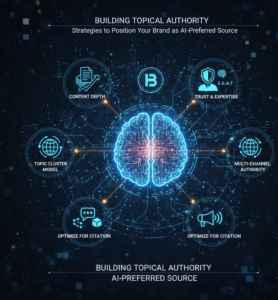Want A Thriving Business? Focus on Graphic Design
Search engine optimisation (SEO) is undergoing a seismic shift. By 2025, over 70% of online searches are expected to be driven by voice and AI-powered queries, fundamentally reshaping how brands approach SEO. At the heart of this transformation lies one critical factor: user search intent.
Gone are the days when SEO success relied solely on keyword density or exact-match anchor text. Today, and even more so in 2025, the key to ranking well lies in understanding the why behind every search. It’s not just about what users are searching for—it’s about why they’re searching and how you can provide the best possible answer.
At Be My Social, we believe that mastering user search intent is the cornerstone of any effective SEO strategy. Let’s explore how you can stay ahead of the curve in 2025.
Why User Search Intent Matters More Than Ever
Understanding user search intent isn’t a new concept, but its importance has intensified. In 2021, Google’s algorithm updates began prioritising content that aligns with user intent, and this trend will only deepen by 2025.
Consider this: 46% of all Google searches are now local, and 27% of the global population uses voice search on mobile. These statistics highlight how user behaviour is evolving. People aren’t just typing queries—they’re asking questions, seeking immediate answers, and expecting personalised results.
To succeed in this landscape, brands must move beyond traditional SEO tactics. Instead of focusing on keywords alone, you need to create content that addresses the intent behind those keywords. Whether it’s informational, navigational, or transactional intent, your content must deliver value that goes beyond a simple answer.
Where to Identify User Search Intent
Google provides a wealth of tools and features to help you decode user intent. Here’s how you can leverage them:
- Analyse SERP Features
Pay close attention to the features that appear for your target keywords. Are there featured snippets, “People Also Ask” boxes or video carousels? These elements reveal the type of content Google deems most relevant to the query. - Explore Related Searches
The “Related Searches” and “People Also Ask” sections are goldmines for understanding user intent. They highlight additional questions and topics your audience is exploring, giving you ideas for content that addresses their needs. - Conduct Competitor Analysis
Study the content that ranks highly for your target keywords. What formats are your competitors using? Are they answering specific questions or providing in-depth guides? Use these insights to refine your own strategy. - Leverage On-Site Analytics
Tools like Google Analytics can reveal how users interact with your website. Which pages are they visiting? What internal searches are they performing? This data can help you identify gaps in your content and better align with user intent.
How to Meet Searcher Requirements in 2025
To truly meet searcher needs, brands must prioritise user experience and value above all else. Here’s how:
- Prioritise Clarity and Conciseness
Users want fast, accurate answers. Avoid jargon and get to the point quickly. Use headings, bullet points, and short paragraphs to improve readability. - Incorporate Visuals
Images, videos, and infographics can make your content more engaging and easier to understand. For example, a step-by-step guide with visuals is far more effective than a wall of text. - Optimise for Mobile and Voice Search
With over 60% of searches now conducted on mobile, your content must be fully responsive. Additionally, optimise for voice search by using natural, conversational language and targeting long-tail keywords. - Enhance User Experience (UX)
A well-designed, easy-to-navigate website is crucial. Ensure your site loads quickly, is secure (HTTPS), and provides a seamless experience across all devices.
Emerging Trends in User Search Intent for 2025
- AI-Powered Search
AI tools like ChatGPT and Google’s Bard are revolutionising how users interact with search engines. Brands must adapt by creating content that aligns with AI-generated answers and provides additional value. - Voice Search Optimisation
Voice search is no longer a niche—it’s a necessity. Optimise for conversational queries and focus on local SEO, as many voice searches are location-based. - E-A-T (Expertise, Authoritativeness, Trustworthiness)
Google’s emphasis on E-A-T will only grow stronger. Establish your brand as an authority by publishing well-researched, credible content and showcasing expertise through author bios and credentials. - Zero-Click Searches
With more users finding answers directly on SERPs, brands must adapt by targeting featured snippets and providing comprehensive, standalone answers.
Conclusion: Staying Ahead in 2025 and Beyond
As Google’s algorithms continue to evolve, understanding user search intent will be the defining factor in SEO success. By analysing search data, leveraging on-site insights, and staying ahead of emerging trends, you can create content that not only ranks well but also drives meaningful engagement and revenue.
At Be My Social, we’re committed to helping brands navigate this ever-changing landscape. Whether it’s optimising for AI-powered search, mastering voice SEO, or enhancing E-A-T, we’re here to ensure your business thrives in 2025 and beyond.
Ready to future-proof your SEO strategy? Contact Be My Social today to learn how we can help you decode user search intent and dominate the SERPs.
A no-fuss attitude and a speedy turnaround!
I’ve found the to be the very best company for us after trying several others over the years.
I’m glad to have them, because the cost of hiring someone directly to do the same work would be impossible.
Highly recommended.
Ruth and Emily are amazing, they are always on hand to answer any questions and explain everything thoroughly.
Our contact Ruth always makes herself available for telephone/zoom meetings, constantly checks up on how sales are progressing and advises on changes to marketing strategies to try and ensure increased traffic to the website. I cannot recommend them highly enough 🙂
Discover More Insights: Explore Our Blog for Expert Tips and Strategies!

Design Theory: The Basics for Beginners in 2025/26
Did you know that in 2025, 94% of first impressions are based on design quality, and with AI tools evolving rapidly, mastering design theory ensures your creations remain human-centred and

Sheffield SEO: Proven Strategies to Boost Your Local Business in 2025/26
Sheffield SEO: Proven Strategies to Boost Your Local Business in 2025/26 Did you know that 46% of all Google searches now carry local intent, and with AI Overviews influencing 65%

Building Topical Authority: Strategies to Position Your Brand as an AI-Preferred Source
Did you know that in 2025/26, zero-click searches account for 65% of all Google queries, with AI Overviews synthesising answers from just a handful of trusted sources, leaving most brands

SEO Yorkshire: 10 Proven Strategies for Dominating Local Search in 2025/26
Did you know that 76% of consumers who search for nearby businesses on their smartphone visit a related store within 24 hours, underscoring the power of local SEO in driving

Grab Readers’ Attention with Engaging Copy: 10 Proven Tips for 2025/26
Boost engagement in 2025/26 with 10 proven copywriting tips to craft compelling headlines, strong hooks and reader-focused content that captures attention fast.

Creating Engaging Content for All Platforms
Did you know that 85% of consumers expect brands to produce content that feels authentic and relatable on social media, yet only 30% believe companies are delivering? As platforms evolve

